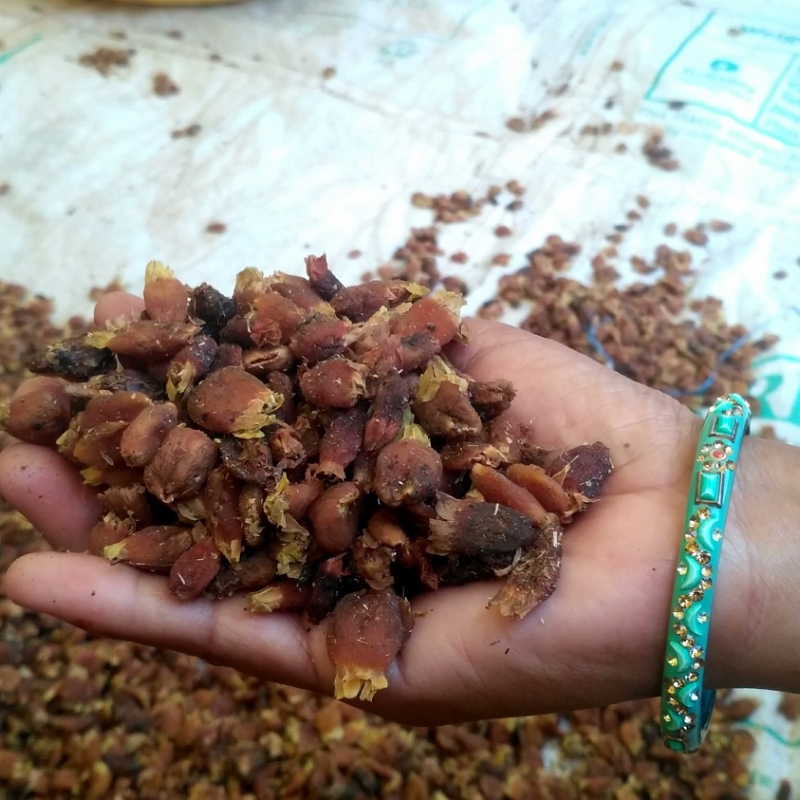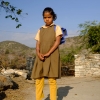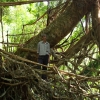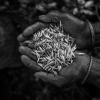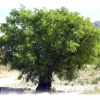Image 1: Ripe Mahua
The Forest and its Afterlife:
The leaves, roots, stems, flowers, fruits, bark, insects and a whole host of components together constitute the forest of Bastar. The animals, insects, humans who thrive in the ecology come together in their ever changing configurations to constitute the forest. When a leaf falls off or a mushroom gets plucked from the undergrowth, it undergoes a transformation. The moment they are gathered by the forest dwelling communities a part of what was the forest now becomes an artifact in a basket; a necessity or a food or a future commodity; the act of dislocating components of the forest also means a death and consequential rebirth of it with a different purpose. The adivasis gather such components primarily for their sustenance and also exchange them in the local haats to buy things which are their daily need. Most of what they need comes from the forest in which they live; however with time and with increasing interaction with the ‘markets of modernity’ the adivasis have also developed a need for certain ‘modern’ commodities. Their gatherings from the forest fetch them the money which they use to buy manufactured goods and commodities. The afterlife of the leaves, roots, stems, flowers, fruits, bark and insects at times takes them far away from where they originated. Each of these components transform into a product as they are gathered and displaced from their point of origin; they cease to be (just) a flower or a fruit or a root, rather they become ingredients for further preparations such as mahua (brewed liquor) or jaggery; or become a food or a drink such as sulphi; or sometimes materials for industrial production such as lacquered varnish and eventually some of it becomes a commodity when they are exchanged and sold in the local markets. They undergo exchange of various hands and get transported to various parts of the country and at times even abroad where they end up as various products ranging from perfume, medicine to paints. These simple components, which exist in the forest of Bastar participate in an incredibly complex afterlife after falling off or are being plucked out of their habitats. Their afterlife in other words constitutes a major part of our modernity. The only difference is that they do not appear as leaves but instead are found listed as ingredients on the products they are used in. Interestingly, the adivasis play a pivotal role in their passing over from one life within the forest to the other beyond it, and the haats of Bastar are the gateways through which they pass through. This article will talk about the period of transition- the passing over and actors that make this transition possible.
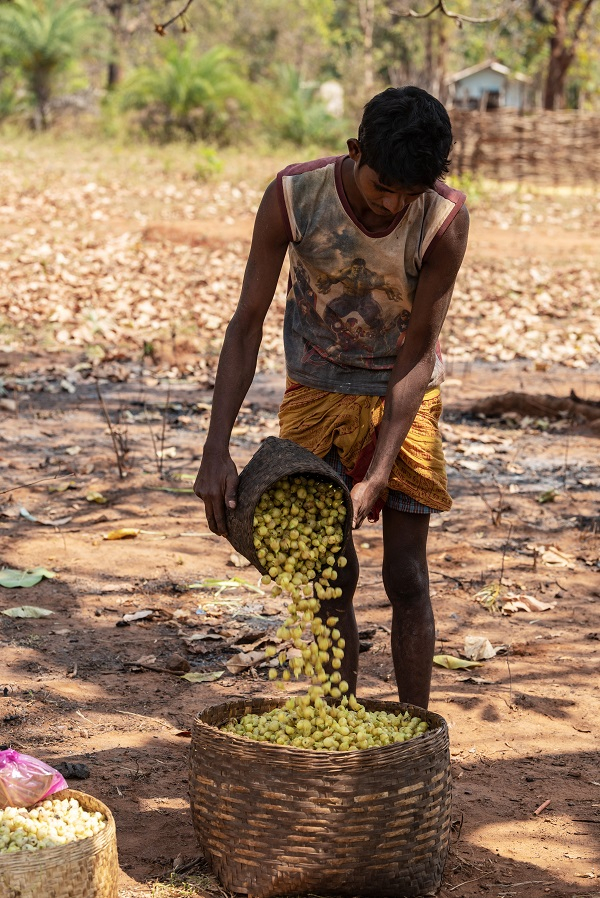
Madhu Ramnath in his book Wood Smoke and Leafcups: Autobiographical footnotes to the anthropology of the Durwa, intricately elaborates the relationship of the adivasi communities particularly of the Koya’s and the Durwa’s– who find their roots as the people of the koya or mahua. The mahua tree (Madhuca longifolia) as many Gonds would attest, is central to the people’s heritage. It forms an integral part of the everyday ritual and cultural practices, in addition to the totemic species of flora and fauna that each clan of the adivasis are ritually bound to conserve and preserve in their everyday lives. Every part of the tree, the flower, the leaves, the fruit, and the seeds find their way in to the everyday of the people. One may often hear of tales and songs about the tree and its spiritual, ritual, and medicinal benefits. After the umbilical cord is cut, few drops of brewed mahua is applied to the infants fresh stump. The elders of the village advise the new parents to feed a few drops of the mahua to the infants for their longevity and physical well being. In the long nights of the summer– one can hear songs of a Gond adivasi who only dreams of a vision of endless mahua trees.
Today mahua serves more than its ritual and domestic use. Rather, now people have also found market for the various parts of the mahua tree. For instance, when a family has picked up more flowers than they can consume or store, they take it to the local trader and exchange the surplus flowers for monetary liquidity. Till now the seed of the mahua fruit– tori was used in the households, but now the tori can be sold to the trader who can help the family connect with a larger market that is willing to buy the seeds for those who practice ayurveda and find immense use of tori. In the same manner, many products of the forest have come to help families supplement their incomes. For some families the produce collected from the forest can earn them enough cash to support them with the purchase of groceries for a week. It has become a common sight to find women and men carry the van upaj collected for sale on the day of the haat. The routine dictates that they first visit the traders sitting in the haats; the transaction is quick wherein the kochiya will quickly weigh the produce (add to the pile of the good), quickly pay the due amount and thereon the seller proceeds to make their purchase for the week.
Many pioneering ethnographic accounts (particularly the descriptions of Verrier Elwin, Eyre Chatterton, and Wilfred Grigson, to name a few) on the lives of the adivasis of Bastar will narrate how the people have always relied on the produce of the forest for their sustenance. The forest produce such as, dried mango pulp, fresh mangoes, mango kernels whole or crushed, flowers of the mahua (Bassia latifolia), mahua seeds, and the fresh or dried fruits of the tamarind (Tamarindus indica), seona (Gmelina arborea), achar or chironji (Buchanania latifolia), tendu (Diospyros melanoxylon), siari or vidhara (elephant creeper, Bauhinia vahlii) to name a few have found one or the other role in the everyday lives of the people. These produce of the forests have been rich sources; and at times have assisted families in supplementing their incomes, and this may not be something as recent as some of us may believe. Many trading communities came to settle across Chhattisgarh decades ago due to the great potential of its forests. One often hears of a story of the times when inhabitants of villages in close vicinity of Hatkarra (a village close to Korar- on Bhanuprattpur–Kanker road)– would exchange chironjee for groceries, such as soap and salt. Pandit Ram Nareti shared during a conversation, that the madhais (melas) organized in the months of shravan (winter), in essence were travelling fairs of Bastar popular for the foreign merchandise that the traders carried with themselves. People would wait for an entire year to buy attractive goods that the merchants sold during the madhais. For this they would often exchange valuable herbs and spices in return for the goods of the cities and towns. The tradition has now taken a routine form when one can spot at least a dozen of women and men carrying potlis of some kind of forest produce (depending on the season) to the local haats.
Today the produce of the forest supplements income for many forest rich villages. It is a common site in the months of June-July to find people selling bamboo shoots, tori (mahua seeds), kusum beej, pemba beej along with scraped lac that they carry from their respective villages to the local traders at the haat. Such a sight was observed at the weekly haats across Kanker. During a conversation with Vinod Chauhan in Hatkarra, a woman approached him (a trader in minor forest produce) to sell the lac she carried from her village in Baskund Panchayat. After weighing the produce, he added them to the mounds and mounds of the maroon reddish resin locally known as Kusumi Lac. Like Chauhan who sits in the weekly haats of Hatkarra, Bhanbeda, Korar, and Bhainsakanhara, there are many traders who can be found in every significant haat of Hatkarra, Korar, Bhanbeda, Puri, Sambhalpur, Bhanupratappur (all in the block of Kanker). They are usually found sitting next to a mound of a variety of non-wood forest products– which keeps increasing as the day progresses. Chauhan shares that he was concluding a season where people brought dried mango slices, which would be transported to the parts of northern India. In next few weeks in the advent of monsoon, he will begin selling dried mahua flowers he has kept stocked in his godown at Korar. He explains that the pattern goes on for the entire year as one forest produce leads to harvesting of the other. Therefore, one will get to see women and men carry a kilo or two of forest products, such as lac that has been freshly scraped from the Kusum tree, get it weighed at the stall of the trader, receive cash from which they make their weekly purchase of groceries.
On further exploration of the local use of products, say lac- one is told that lac does not find much use in the everyday activities of the people. At most, it is used to seal the earthen pots while cooking. However, having realise the potential of lac in the global markets and its use in various pharmaceutical industries, cosmetic industry, paint industry, and food industry, the trading community began acquiring and aggregating lac from various local markets (through their widespread network of kochiyas) and went on to sell the resins to various processing units, henceforth, leading to its export in the international markets. Thus, what one sees is women and men carrying a red scrapings of lac, a resin that once occurred freely in the forests is today being cultivated in districts like Uttar Bastar Kanker of Chhattisgarh (till about 2012 as one of the largest lac producing districts in the country).
So how does lac, a resin reared on the branches of kusum tree finds its way into the perfume or paint? For that matter, how does any product that is found in the forests of Bastar reach the consumers in the markets of the cities? The following section will elaborate on how the product of the forest embarks on a journey to its after-life when it reaches to a wider base of consumers.
From Fruits and Flowers to a Commodity:
A pertinent question for exploration here is how a fruit of the forest becomes the produce/product in the market? When does chironjee, kusum beeja, vidhara, tori beeja, saal beeja or pemba beeja become the products for exchange value in the haats? For instance, beginning from the last weeks of April through the month of May, one finds young and picking fallen flowers from the Mahua tree. Once these flowers have been collected, the people sell a part of what they have collected to the kochiyas or local traders. Kochiyas then either store the mahua flowers in their rented facility or aggregate the mahua flowers from across the haats and sell it to a bigger trader. Mr.Pushkar Sinha is one such trader who sits in the haat of Korar. Korar is not only a village haat but is also an aggregating point. Many small traders come and sell their stocks of minor forest produce procured from various village haats to middle level traders such as Sinha. Thus, Sinha purchases these products from the people directly and also from the kochiyas. He explained, that the flowers of the mahua tree are sold in the market during the months of April, through May up till first few weeks of June. Interestingly, the same mahua flowers will return to the markets in the post monsoon season, when the Adivasis will need to brew mahua for ritual and cultural practices.Thus, the seller of the product becomes the eventual buyer of the dried mahua flowers. Sinha elaborated that this was one product that came back to the same market where the seller became the buyer too. While the trader would purchase mahua at a rate of Rs.45-50 per kilo in the monsoon months he is able to sell back at a rate of Rs.70 to 80 per kilo. As a trader, besides the cost of storage, he described that he is able to make a fair profit of this one fruit of the forest.
As one explores the various haats across Bastar and engages with various other traders, one quickly realizes that no one trader trades in just one kind of non-wood forest produce. For instance, Chauhan himself trades in Mahua, Lac, Pemba Beeja, Saal Beeja and the Sal leaf, grains like fox millets, pearl millets, kodo millets, chironjee, tamarind, dried mango slices, so on and so forth. This is true for Chauhan’s counterparts who are spread across Bastar.
To form a grounded understanding of the flow of trade and how the produce of the forest moves from the forest into the hands of the consumer, the following section will seek to elaborate on how the trade and routes get organized across Bastar.
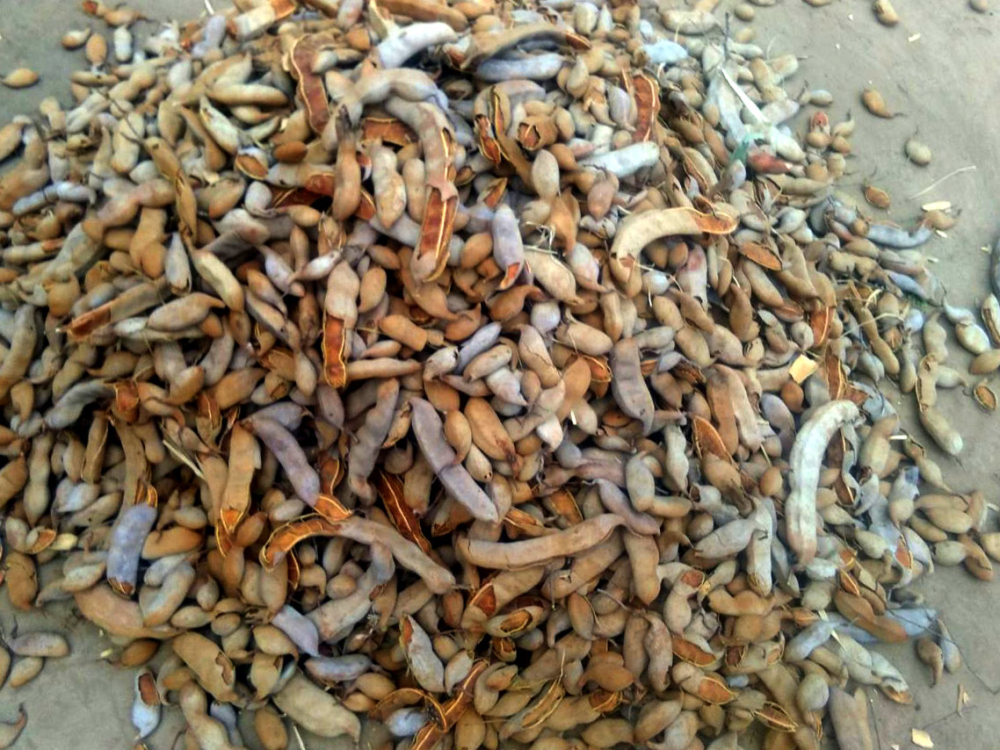
Traders and the Trade Routes:
Let us begin with an example of the haats in the district of Uttar Bastar Kanker– which is the gateway to the riches of Bastar. In the block of Kanker there are few haats that act as collection units. The biggest or central collection point in the trade of van upaj is Sambhalpur, which is home to many bigger traders. The next significant haat is Korar, which is the next hub of big merchants. Similarly, Charama, Gattasilli (Dhamtari), Akladongri, Keshkal, Gotulmunda are important collection points, as well as important junctions in the trade of forest produce.
Chauhan and many traders like him function in a market that has multiple layers of traders ranging from the rich merchants (with social and economic capital at their disposal) on one end to the small scale traders who travel from one village to another, collecting various kinds of van upaj. These Kochiyas accumulate various forest produce from the village haats and bring the collected stock to aggregation points such as the haats of Korar, Bhanupratappur, Kanker, Sambhalpur, Kehskal, Charama, and so on. Thus, one finds a network of small traders who sit across region village haats linked with the middle level traders who buy the aggregated stock from the kochiyas, and then they sell the stock to a richer merchant who will have access to processing units and markets across the nations.
Since the trade involves cash transactions at every stage, particularly when acquiring the produce from the villages, these networks also function on the lines of loan. For instance, Pushkar Sinha will give a kochiya like Chauhan credit so that he can procure, say tamarind from the villages. Every week Chauhan will sell his weekly accumulated product to Sinha. However, till the time Chauhan has sold his accumulated stock he will have a small storage facility in the nearest town. Monetary liquidity and cost of storage facility are important factors that determine the scale at which a trader can function. Further the traders are required to pay a rent for the space they occupy at the haat to the local haat committee. This further limits how many haats a kochiya can visit. Thus, a kochiya can visit four, at most five haats in a week, and also maintain a small facility to store his weekly procures.
Throughout the year kochiyas across Bastar aggregate minor forests produce across local haats and sell their aggregated stocks to the relatively bigger traders and merchants. The markets where the middle and bigger traders sit are known as aggregating points. Bigger traders like Bhomraj Jain or Harish Jain will have his main stationed at the important markets. For instance, one such aggregation point for Kanker is in Sambhalpur. The produce as acquired from the people at various levels of haats are brought and stocked at this aggregating center.
Thus, the aggregated produce from various village and town level haats are brought to the storage facilities of the bigger merchants. The rich merchants then contact the buyer for his stock. Say for lac, the merchant will contact processing units in Dhamtari, Janjgir Champa, Shakti. For tamarind he may contact traders in Raipur who will put him in touch with merchants who trade in the southern parts of the country. But before the produce can leave the district border, the merchants are required to acquire clearance from the van upaj mandi (stationed in each district) that will grant a certificate for the movement of the forest produce. The big traders maintain contact with owners of factories and processing units. The trade for all non-wood forest produce is organized in a similar fashion. A vast network of kochiyas, traders, and merchants work in tandem to control and organize the movement of the produce of the forest, a system of trade developed and made efficient over the decades ensuring a smooth functioning of market for minor forest produce scattered across vast geographical expanse.
Conclusion:
The role of traders in the trade of non-timber forest produce from the discussion suggests a system of network that has been perfected over time. Although, the traders may not appear to add greatly in terms of value in the supply chain of the NTFPs yet their essentiality cannot be undermined. They are essential actors that make the afterlife of the van upaj possible. At present, this elaborate network of traders and merchants appear almost indispensable in ensuring that the fruits of the forest are carried out in to the global circuits of capital. This system of trade ensures a supplementary income to the rearers or collectors of forest produce, while at the same time reducing their transportation costs by procuring produce form the local haats readily provide liquidity. The relationship between migrant trading community and the communities who have always resided in the region– definitely have undercurrents of inequity. Such is true across the region of Chhattisgarh where the migrant merchant/trading communities have over taken businesses and trades (labour contractors of central Chhattisgarh being a case in point). However, these traders and merchants, who may seem invisible are the essential cogs in the trade of minor forest produce who are responsible for ensuring the movement of a larger and valuable trade both nationally and internationally.
This content has been created as part of a project commissioned by the Directorate of Culture and Archaeology, Government of Chhattisgarh, to document the cultural and natural heritage of the state of Chhattisgarh.
